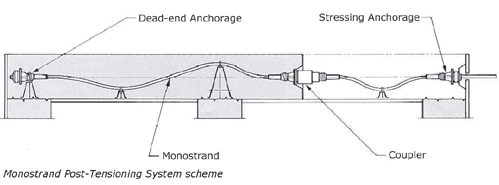Bonded and unbonded multistrand post-tensioning system
VSL post-tensioning systems are certified according to European Technical Approval which can be used in all EU/EFTA countries. A post-tensioning tendon consists of strands, duct, and anchorages. Tendons of the multistrand VSL system may be made up of as much as 55 seven-wire strands of 15.7 mm (0.6“S) in diameter with a guaranteed ultimate strength of 1860 MPa. The prestressing steel applied corresponds to international standards EURONORM 138-79, ASTM A 416-85, BS 5896. Ducts are made of either steel or plastic PT-Plus. Tendons are fitted with a wide variety of live and dead anchorages and couplers according to the demands of different structures, concreting sections, or technologies. After initial tensioning, the tendons of the bonded post-tensioning system are grouted with cement mortar, which protects strands against corrosion and ensures the co-operation of the tendon in every cross section of the post-tensioned structure. For the unbonded system, each strand is placed within a HDPE pipe injected with grease, which provides another 2 stages of corrosion protection to strands.

Bonded slab post-tensioning system
VSL bonded slab post-tensioning system has been successfully applied in many projects of building and bridge engineering. The post-tensioning system consists of a flat duct filled in with 4 prestressing strands, and live or dead-end anchorages. Thanks to the duct’s flat shape, the system maximally uses the limited static height of slab structures, thus increases the effect of the introduced prestressing. Individual strands of tendon are prestressed one after another and subsequently grouted with cement mortar ensuring both the composite action with structure and corrosion protection. The system is involved in redistribution of cracks, if any. In comparison with the traditional reinforced concrete structures, future saw-cuts are not limited, the cut-off of post-tensioning tendon is possible without any further provisions, and the effect of prestress is lost only in the concerned span.
Monostrand post-tensioning system
Single-strand unbonded post-tensioning system known as monostrand uses 15.2 mm (0.6“) or at present mainly 15.7 mm (0.6“S) diameter strands sheathed in a HDPE pipe with grease. This provides an excellent double corrosion protection and very low friction losses. The external diameter of monostrand tendons is 19 mm. The installation of this lightweight system is extremely quick. Thanks to its dimensions, it can be used also for very slim structures and is very flexible in coordination with rebar reinforcement. After tensioning, the formwork can be immediately striped, which brings considerable savings in costs of support structures.
External tendons
External post-tensioning is commonly used in bridge engineering, for example by reason of insufficient space available for tendons inside the structure, but especially with respect to a high degree of corrosion protection, the possibility to inspect tendons during their service life and easy replacement, if necessary. This is a great advantage and often the only solution for increasing the carrying capacity of the existing bridge structures. The external post-tensioning may be also used for strengthening or fastening the structures of buildings, silos and reservoirs.
Tendon ducts and corrosion protection
For ducts of the bonded post-tensioning system, thin sheet metal pipes with claw coupling or welded overlapped seam supplied in lengths of 5 and 6 m respectively are used as a standard. Ducts are connected to each other by an external screw coupling and sealed with PE tape. On the other hand, the optional system of PT-Plus® plastic ducts offers many advantages compared to traditional steel ducts. Thanks to the PT- Plus® couplings with double sealing the duct is watertight, the friction losses are considerably reduced and fatigue resistance of tendon is considerably improved. Ducts are supplied in length of 5.8 m. The system of PT- Plus® plastic ducts in combination with GC and VSL CS 2000 Plus anchorages meets the requirements of PL2 corrosion protection level – fully encapsulated tendon; if combined with VSL CS 2000 Super anchors it meets the requirements of PL3 corrosion protection level – monitorable, electrically isolated tendon (fib Report 33). The electrically isolated post-tensioning tendons are reliably protected even in the environment with a high occurrence of stray currents. Furthermore, the system offers the possibility to monitor the quality of installed tendons through measurement of electrical resistance (impedance) between strands and rebar reinforcement of the load bearing structure. The monitoring of corrosion protection integrity through this method can be conducted anytime during the life cycle of the structure. It is even possible to localise the point of tendon’s leakage.
Stressing
VSL post-tensioning systems use a unique system for anchoring the prestressing force. The strands always remain in contact with the anchoring wedges during the stressing operation. As the pressure in the press is released, the strands are automatically locked in the conical holes of the anchor head.
Grouting
The objectives in grouting a tendon are twofold:
- To provide an effective corrosion protection by completely filling the tendon duct with alkaline material (grout);
- To achieve an effective composite action so called bonding of prestressing steel with the structure.
- Grouting mixture fulfils the valid EN 447:2007
The complete filling of all cavities in the post-tensioning tendon prevents moisture from accumulating in the structure, which may result in corrosion and development of cracks in the structure during the freeze thaw cycles.

















